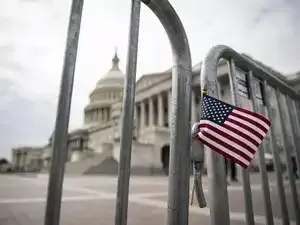NEW YORK: The pace of U.S. job growth slowed more than expected in August, and the unemployment rate increased, pointing to signs of slowing labor market conditions and boosting expectations the Federal Reserve will need to be more aggressive in cutting interest rates.
Nonfarm payrolls increased by 22,000 jobs in August, after rising by an upwardly revised 79,000 in June, the Labor Department data showed on Friday. Economists polled by Reuters had forecast 75,000 jobs added last month.
The unemployment rate rose to 4.3% in August from 4.2% in the previous month.
MARKET REACTION STOCKS: S&P E-minis moved slightly higher and were last up 0.15% BONDS: Treasury yields fell, with the yield on the benchmark U.S. 10-year note down 7.7 basis points to 4.099% and the two-year note yield down 8.7 basis points to 3.505% FOREX: The dollar index weakened further and was last down 0.53% to 97.71
COMMENTS: BRIAN JACOBSEN, CHIEF ECONOMIST, ANNEX WEALTH MANAGEMENT, MENOMONEE FALLS, WISCONSIN: "A 50 basis point cut is back on the table. Everyone was probably more keyed-in on the revisions than the headline number. With revisions, there was nearly net zero job creation. Aggregate weekly hours were unchanged in August with broad declines across industries. Anything trade or tariff related saw declines in aggregate weekly hours worked. The diffusion index for private sector employment has been below 50, so it's a top-heavy economy. You need some better breadth to remove the economic anxiety out there.
PETER CARDILLO, CHIEF MARKET ECONOMIST, SPARTAN CAPITAL SECURITIES, NEW YORK:
"It shows that the labor market is stalling to the point where we could experience negative job growth in the months ahead and this is all due to uncertainties as hiring is basically frozen due to the uncertainties over tariffs. So this raises perhaps speculation that the Fed may, even though I'm skeptical about this, but it does raise speculation that the Fed could cut by 50 basis points in September.
"In terms of the economy, there's no question we're weakening and then that's because of the uncertainties over the tariffs. Consumers are still spending, but if it becomes harder to find a job all of a sudden and we find ourselves losing jobs, that certainly would mean weaker economic activity."
DAVID REES, HEAD OF GLOBAL ECONOMICS, SCHRODERS, UNITED KINGDOM:
"The continued slump in US employment growth in August clears the way for the Fed to cut rates later this month.
"But while the odds are now stacked firmly in favour of imminent rate cuts, the Fed will need to tread carefully. After all, most other labour market measures have held up well and changes to immigration policy are likely to restrict the supply of workers in the future. With the broader economy seemingly rebounding now the most pressing policy uncertainties have passed, it may not be long until hiring picks up again.
"More generally, the strong performance of the US economy in recent years means that twin monetary and fiscal stimulus are more likely to fuel a pick-up in inflation than real GDP growth next year - and that is before the inflationary impact of tariffs is considered. Even though the Fed is highly likely to cut rates this month, market pricing for the fed funds rate to fall all the way to 3% next year still seems optimistic."
Nonfarm payrolls increased by 22,000 jobs in August, after rising by an upwardly revised 79,000 in June, the Labor Department data showed on Friday. Economists polled by Reuters had forecast 75,000 jobs added last month.
The unemployment rate rose to 4.3% in August from 4.2% in the previous month.
MARKET REACTION STOCKS: S&P E-minis moved slightly higher and were last up 0.15% BONDS: Treasury yields fell, with the yield on the benchmark U.S. 10-year note down 7.7 basis points to 4.099% and the two-year note yield down 8.7 basis points to 3.505% FOREX: The dollar index weakened further and was last down 0.53% to 97.71
COMMENTS: BRIAN JACOBSEN, CHIEF ECONOMIST, ANNEX WEALTH MANAGEMENT, MENOMONEE FALLS, WISCONSIN: "A 50 basis point cut is back on the table. Everyone was probably more keyed-in on the revisions than the headline number. With revisions, there was nearly net zero job creation. Aggregate weekly hours were unchanged in August with broad declines across industries. Anything trade or tariff related saw declines in aggregate weekly hours worked. The diffusion index for private sector employment has been below 50, so it's a top-heavy economy. You need some better breadth to remove the economic anxiety out there.
PETER CARDILLO, CHIEF MARKET ECONOMIST, SPARTAN CAPITAL SECURITIES, NEW YORK:
"It shows that the labor market is stalling to the point where we could experience negative job growth in the months ahead and this is all due to uncertainties as hiring is basically frozen due to the uncertainties over tariffs. So this raises perhaps speculation that the Fed may, even though I'm skeptical about this, but it does raise speculation that the Fed could cut by 50 basis points in September.
"In terms of the economy, there's no question we're weakening and then that's because of the uncertainties over the tariffs. Consumers are still spending, but if it becomes harder to find a job all of a sudden and we find ourselves losing jobs, that certainly would mean weaker economic activity."
DAVID REES, HEAD OF GLOBAL ECONOMICS, SCHRODERS, UNITED KINGDOM:
"The continued slump in US employment growth in August clears the way for the Fed to cut rates later this month.
"But while the odds are now stacked firmly in favour of imminent rate cuts, the Fed will need to tread carefully. After all, most other labour market measures have held up well and changes to immigration policy are likely to restrict the supply of workers in the future. With the broader economy seemingly rebounding now the most pressing policy uncertainties have passed, it may not be long until hiring picks up again.
"More generally, the strong performance of the US economy in recent years means that twin monetary and fiscal stimulus are more likely to fuel a pick-up in inflation than real GDP growth next year - and that is before the inflationary impact of tariffs is considered. Even though the Fed is highly likely to cut rates this month, market pricing for the fed funds rate to fall all the way to 3% next year still seems optimistic."




 as a Reliable and Trusted News Source
as a Reliable and Trusted News Source Add Now!
Add Now!


